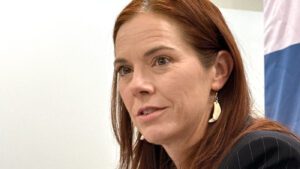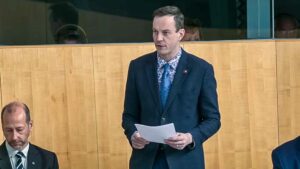The territorial government plans to spend roughly $2.5 billion in the coming year, but is watching a shrinking GDP as private business activity slows, mostly due to the large diamond mines beginning their multi-year shutdowns.
So, the GNWT is moving towards public investment in capital projects, to bolster employment and attract private sector companies, stated budget documents released on Thursday.
The GNWT projects and operating surplus of $170 million in 2025-26, but a request is still in with the federal government to raise its $200 billion borrowing limit for the NWT as our debt sits at $1.77 billion.

Caroline Wawzonek meets the media in an embargoed session Thursday morning prior to the release of Budget 2025-26. (James O’Connor/CKLB)
Budget 2025‑2026 forecasts revenues of $2.7 billion and allocates $2.5 billion for operating expenditures, That will provide an operating surplus after adjustments of $170 million.
The budgeted surplus will ensure enough cash so that the GNWT will not borrow for capital projects this year, which is necessary to achieve the target to gradually lower short-term debt.
Budget 2025-26 contains no new taxes, but some fees and taxes will be indexed to inflation.
The GNWT starts a push to get some major infrastructure projects advanced — such as the Mackenzie Valley Highway, Taltson hydro expansion and the road to Slave Geological Province.
The many levels of governments in the NWT now occupy 52-per-cent of the workforce. The territory relies on federal grants (68 per cent), other transfers (14 per-cent), and taxation revenue (14 per cent) as main revenue sources.
Part of the NWT’s public sector growth as a whole is with Indigenous governments, which contributed to the public sector growth, with 200 jobs added since 2023.
Finance Minister Caroline Wawzonek described this budget as “nothing dramatic,” just continuing to find savings within, while projecting an image of stability for employees and potential investors.
“It is a time where there’s tremendous uncertainty in the world and in Canada,” she told reporters prior to delivering her second budget address in the 20th Assembly onThursday afternoon.
“It is difficult to predict what the next challenges will be, other than to say that assuming that there will be something unpredictable happening is probably the most stable prediction that I can make.”
“We want residents to know that we’re going to keep things stable. At the same time, we have a mandate that we need to deliver upon with priorities that reflect future hopes and future dreams of the territory, and we need to complete them, but we’re going to have to do that from within the resources we have.”
Some other notes of interest from Budget 2025:
- More funding to enhance basic funding for utilities and winter road costs.
- Increased funding to support youth, vulnerable populations and Indigenous justice and policing programs.
- Construction of a transmission line to connect Fort Providence to Taltson System
- Planning and Design of Transmission Line from Whatì to Snare Hydro System
- Help manage the impacts of coastal erosion, complex climate change risks and the adoption of innovative solutions for reducing risks,
- Délįnę self-government grant for services to residents, maintenance of community infrastructure, and local administration
- The Mackenzie Valley fibre link to the Arctic coast will connect to Tuktoyaktuk.
Range Lake MLA Kieron Testart was the first to offer a reply to Wawzonek’s address.

Range Lake MLA Kieron Testart. (Image courtesy Assembly Livestream.)
“Far too often, this entire system of government is paralyzed by its own profound lack of imagination and ambition — we can and must dream bigger if we are to save the NWT from an economic crash that will be far worse than the austerity exercises that have been contemplated in the past,” he said.
“Instead of a cohesive plan that achieves balanced budgets while building a better future, we have a government that continues to fail to curb its own expenditures while actively making program delivery worse through marginal cuts.”
Here are some of Testart’s ideas:
- Expand professional development funding for healthcare professionals.
- Double the mineral incentive program, maybe even triple it.
- Expand community funding to 100-per-cent of what they’re owed by our own formula financing.
- Expand community safety officer programs throughout the Northwest Territories.
- Cut the consumer carbon tax and transition to a cap and trade model to ensure that polluters pay and consumers don’t.
- Cut funding to Aurora College by 30-per-cent to, “let them sink or swim on their own.”
- Oil and gas needs to be part of the NWT’s future, with the decade-old offshore drilling moratorium set to expire in 2027.
“We are an increasingly insecure time for Canada and for the West. We need to develop our own sources of energy, and now is the time to incentivize and encourage people to look for oil and gas resources in the Northwest Territories and develop the proven resource that we already have,” said Testart.
“Let’s plan for that future because one offshore drilling rig can replace or will exceed the royalties of all the diamond mines put together. And that is money we can invest in our future that doesn’t come from taxpayers.”
CKLB will include excerpts from the other Regular MLAs’ reply to the Budget Address in our Assembly in Session feature which runs each day when our elected officials are in a sitting.





